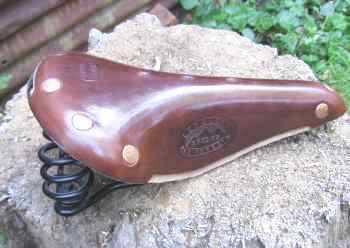[ 63XC.COM | REVIEWS | BROOKS CONQUEST ]
Brooks Conquest
Grasshopper has a truly terrible ride. Grasshopper is an ancient Elswick-Hopper which I bought as a town fix. When it turned out too heavy for skinny tyres, I put on fatties and started riding the local bridleways, thus engendering 63xc.com and a bunch of other good stuff. Since I owe the old bicycle so much, I've been reluctant to criticise it in print. Instead, I quietly switched to another machine for road work and got on with it. But I was forced to take Grasshopper on the road last spring, and I had a particularly hard time. The fork and stays, being built of gaspipe (US: rebar) transmitted every bump. After ten miles, I found myself numbing up. If this was what a long ride on tarmac was like, what about cumulative damage from riding the chalk paths of home? I figured a sprung saddle was a good idea. I couldn't find the old Brooks that I wanted, so I decided to go for a new Brooks instead. The Brooks Conquest for which I shelled out is deliberately targetted at the offroad market, with 'All Terrain' stamped into the leather and a choice of colours for the metalwork that includes some very un-roadster neons. That said, the construction will be familiar to anyone who has looked at a butcher's bike: two approximately triangular chassis elements of bent steel rod have a common apex in the nose of the saddle while at its rear their bases are kept apart by two massive coil springs. The construction is typically faultless. (I've seen neglected Brooks saddles, but never a badly-made one.) The leather is chocolate brown, thick, and held to shape on the chassis by exquisite hand-hammered rivets. The springs are massive chunks of Edwardian metalwork: if I take a firm two-handed grip on the back of the saddle, I can compress them about 3mm. The Conquest is broadly comparable with the familiar B-17 in profile--that is, not as slim as the racing models, but slender enough to spin on. The sides seem deeper than usual, presumably so as to prevent any contact between thigh and chassis. No Swift-style cutaways here. No weight savings of any kind, in fact. The Conquest tips the scales at a substantial 900g. Before stumping off back to the Selle Italia catalogue in disgust, however, you should reflect on two things: i. Brooks products have a lifespan measurable in decades and ii. a fully-rigid bike with a 900g saddle may work out lighter than a bling-encrusted dual suspension job. That being the case, how does it work? Setup is logical but odd. Under load, the springs compress, pushing down the rear of the saddle relative to the nose. You have to allow for this by tipping the nose down. The centimetre or two of incline looks rather strange. It works well, however. At least, within my parameters of usage. Modern suspension seatposts use elastomers and complex geometry to stay inert through the small bumps and to pad out the big ones. The Brooks, however, predates the concept of rising rate. It responds to all shocks with the same degree of damping, so that one feels a constant mild level of 'boing'. (Londoners: it's like walking over the Millennium Bridge before it was re-engineered.) This simple linear behaviour has good and bad points. It means that your springs will last forever, but it also means a risk of what bikers call 'bottoming out', that is, hitting a bump too big to be absorbed by the suspension even at maximum compression and so transmitting a nasty shock. I haven't had this yet, although I should point out that my riding is gentle distance stuff, not wild dirtjumping. My own experience has been of comfort, ease, and improved concentration on longer trips. Handling is fine. It's weird to have the rear plush while the front bangs, but I just shift my weight back for bumpy stretches. The saddle is massy enough that I notice its inertia when I fling the bike around during out-of-the-saddle climbs. I still find it slightly surprising that the saddle follows me part of the way when I lift up to climb a hill. There are occasional creaks which call for WD40. I won't dwell on these trivia. More serious is the issue of long-term care. Unless you ride with mudguards (fenders) all the time, the Brooks' soft underside will inevitably pick up mud and water, hastening its demise if the saddle is not dried and re-proofed promptly. Do you polish your leather shoes regularly? If not, you might look elsewhere. But, if you are prepared to look after it, this really is the kind of product which lasts a lifetime. And it does a reasonable job of smoothing out the bumps, too. Recommended.
[ TOP ] |
Writer
Will Meister sells fixed gear kit on the web, but doesn't have any plans to stock Brooks saddles.
Date
v1.0 written August 2005
Related
The alternative is a suspension post like the Cane Creek offerings, less elegant than the Brooks but getting cheaper all the time.
Mailing list
Join the 63xc.com list.
